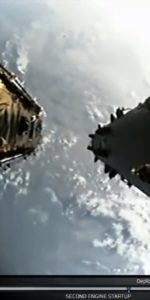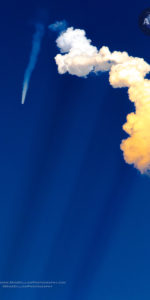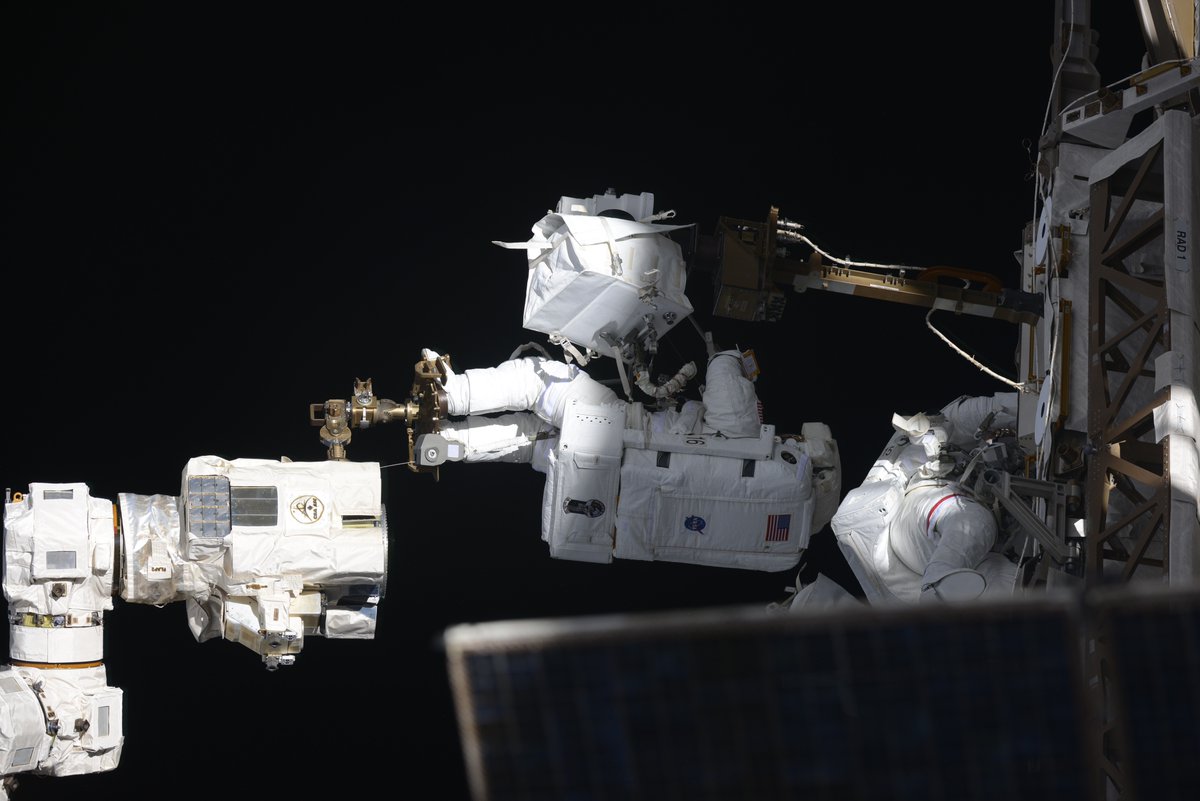
The U.S. Marine Corps is celebrating a new service record today, after Expedition 53 Commander Randy “Komrade” Bresnik—a retired colonel—became the service’s most seasoned spacewalker. Having already become the first Marine to embark on a long-duration voyage to the International Space Station (ISS), when he launched aboard Soyuz MS-05 in July, and the first Marine to command the multi-national orbiting laboratory in September, he chalked up his fourth career spacewalk today (Tuesday, 10 October) and totaled 25 hours and 11 minutes. In doing so, Bresnik eclipses the previous record-holder, fellow Marine Carlos Noriega, who performed three sessions of Extravehicular Activity (EVA), totaling 19 hours and 20 minutes, during the STS-97 shuttle flight in late 2000.
In spite of their enormous contributions to human space exploration, spacewalking has been a surprising rarity for the Marine Corps, with only four astronauts having ventured into the near-total vacuum of space in the last 44 years. The first, Jack Lousma, performed two sessions of EVA outside the Skylab space station in August 1973, during which he installed a twin-pole sunshade for thermal protection. “It’s like gliding along on this magic carpet,” he later told an interviewer, “going into the sunset and sunrise, every hour-and-a-half…doing that for six hours.” From Lousma’s perspective, freeways and cities and airports could be seen with the naked eye and the Home Planet was visible, not partially, through a window, but in its entirety, as a sphere. This was a phenomenon which struck Randy Bresnik during last week’s EVA. “On a #spacewalk,” he tweeted, “the Earth never lets you forget you are 250 miles/400 km high.”
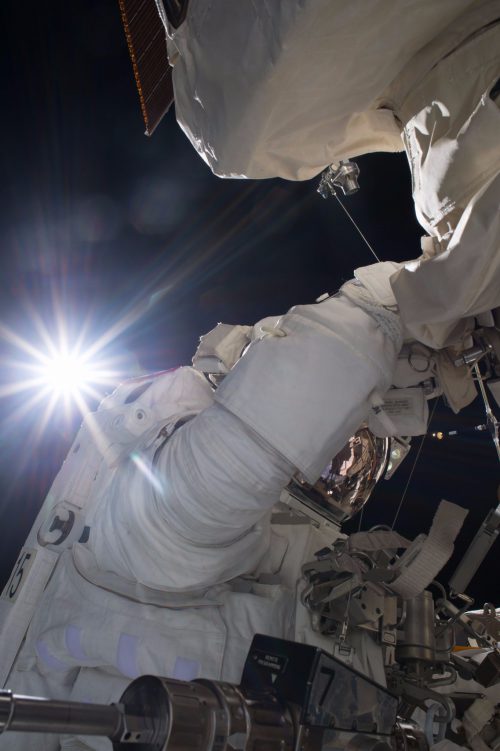
After Lousma’s experience, Gerry Carr went on to perform three EVAs outside Skylab between December 1973 and February 1974—including the only spacewalk ever performed on Christmas Day—one of whose objectives was photography of Comet Kohoutek. Carr totaled 15 hours and 49 minutes. More than a quarter-century elapsed before a third Marine went EVA. In early December 2000, STS-97 astronaut Carlos Noriega performed three spacewalks, totaling 19 hours and 20 minutes, to install and activate the P-6 truss segment and solar array “wings” aboard the ISS. Bresnik made two EVAs on STS-129 in November 2009, then came close to breaking Noriega’s Marine Corps record last week, during U.S. EVA-44, when he reached a personal tally of 18 hours and 45 minutes.
The excitement of simply performing a spacewalk, much less breaking a record, has clearly been on Bresnik’s mind in recent days, as both he and Expedition 53 Flight Engineer Mark “Sabot” Vande Hei have shared stunning imagery from their initial EVA together. “I won’t forget the sudden spacious feeling when the hatch opened and bright white light flooded in,” tweeted Vande Hei, who made his first career spacewalk and became the 221st human to go EVA since Alexei Leonov, way back in March 1965. Yesterday (Monday), he followed up with a stunning view of Japan’s Kibo lab, seen from his spacewalking perspective. “It’s hard to soak it all in,” he tweeted. “I look forward to more opportunities tomorrow.”
With EVA-44 having been primarily tasked with the removal and replacement of a degraded Latching End Effector (LEE)—one of two at opposite ends of the 57.7-foot-long (17.6-meter) Canadarm2 robotic arm—one of the activities for today’s EVA-45 was lubrication of the central ballscrew in the newly-fitted unit. Additional responsibilities for Bresnik and Vande Hei included the rotation of a spare Pump Flow Control Subassembly (PFCS) and the replacement of a degraded camera and lens cover. Overseeing today’s spacewalk from the Mission Control Center (MCC) at the Johnson Space Center (JSC) in Houston, Texas, was a team headed by Flight Director Judd Frieling and Capcom Kate Rubins, herself a veteran of two EVAs in 2016.
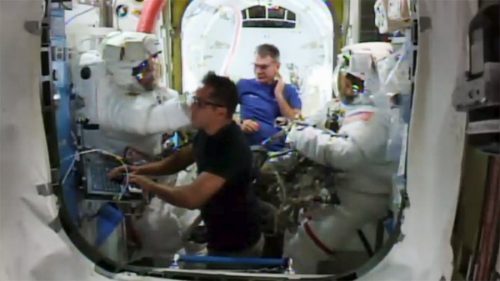
With a four-strong U.S. Orbital Segment (USOS) crew currently aboard the station, Bresnik and Vande Hei were heavily dependent upon fellow Expedition 53 astronauts Joe Acaba and Italy’s Paolo Nespoli; the former was responsible for suiting them up in the Quest airlock, whilst the latter handled Canadarm2 duties. After a quick breakfast, the spacewalkers spent about 60 minutes “pre-breathing” on masks, as the inner “equipment lock” was depressed from its ambient 14.7 psi to 10.2 psi, allowing for suit checks and purging. It was then repressurized to 14.7 psi, enabling Bresnik and Vande Hei to undertake a nominal pre-breathing regimen and 50 minutes of In-Suit Light Exercise (ISLE).
At around 7 a.m. EDT, Acaba and Nespoli transferred the fully suited duo into the outer “crew lock”, closed the connecting hatches and initiated depressurization. When the crew lock reached a condition of near-vacuum, at about 0.5 psi, Bresnik was given the go-ahead to open the hatch into space. U.S. EVA-45 officially commenced at 7:56 a.m. EDT, when the spacewalkers transferred their suits’ life-support utilities onto internal battery power. They emerged into orbital darkness, heading over the South Pacific Ocean, off the coast of Chile, at an altitude of 250 miles (405 km). As is customary, they pressed directly into “buddy checks” of each other’s suits, including gloves and Helmet Absorption Pads (HAPs), together with tethers and tools, before heading to their first respective worksites.
According to Glenda Brown, the spacewalk officer for U.S. EVA-45, preparing for today “takes a village” of work from the standpoint of personnel on-orbit and on the ground. In short order, Bresnik completed his first task of reconfiguring a latch on Quest’s High-Pressure Gas Tank, which was slightly out of its “locked” position, then collected an Articulating Portable Foot Restraint (APFR) and made his way to the port side of the U.S. Destiny lab. Here he assembled and ingressed the APFR to prepare for the rotation of a Pump Flow Control Subassembly (PFCS). These boxy units, weighing around 250 pounds (113 kg), contain most of the controls and mechanical systems responsible for circulating ammonia through the station’s external coolant loops. At 8:31 a.m., Bresnik surpassed Carlos Noriega’s record for the greatest number of EVA hours by a Marine Corps astronaut.
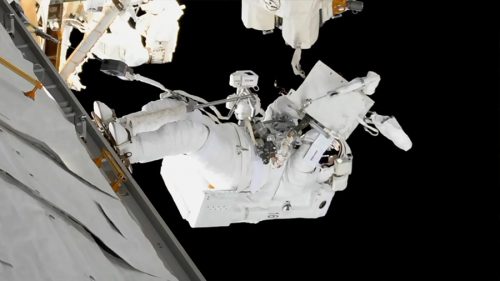
Meanwhile, Vande Hei began his work by heading along the airlock “spur”, onto the Integrated Truss Structure (ITS), in a portward direction to reach the Mobile Transporter (MT) and the port-side Crew and Equipment Translation Aid (CETA) Cart. He stowed his tool bag at 8:15 a.m. and collected an APFR from the cart, which he installed onto Canadarm2. In order to do that, Vande Hei needed to attach a socket onto the new LEE. The foot restraint was securely in place by 8:30 a.m. He then returned to the Destiny lab to assist Bresnik with the PFCS rotation.
Although active PFCS units are in operation on each Integrated Equipment Assembly (IEA) on the truss-based photovoltaic modules, the unit tended today by Bresnik and Vande Hei is actually a spare. It was delivered to the station back in March 2001, by the STS-102 shuttle crew, and resides on External Stowage Platform (ESP)-1 on Destiny’s port side. The spacewalkers were required to rotate it through 90 degrees, thereby providing a clear path for the venting of ammonia coolant, prior to its eventual relocation to the P-6 truss on a future spacewalk. The two spacewalkers worked together to rotate the PFCS and the task was completed by 8:45 a.m.
With the PFCS rotation behind them, Vande Hei returned to the port side of the truss and separated his tool bags, taking the Medium ORU Bag with him. He ingressed the APFR and Nespoli, at the controls of Canadarm2, swiftly maneuvered him over to the Camera Port-9 location, situated on the lower-outboard face of the port-side P-1 truss. Bresnik returned to the Quest airlock to collect a Large ORU Bag, holding a replacement camera group, and rejoined Vande Hei at the worksite. They removed the high-definition camera by 9:40 a.m. The camera has exhibited a pinkish hue, caused by a failed color wheel, over the last couple of years. Wrapping up this task, Bresnik returned again to the airlock at 10:30 a.m. to stow the failed camera group.
By now adept at spacewalking, well into his second career EVA, Vande Hei labored to complete the installation of the high-definition camera. Nespoli then maneuvred him back to the truss, where he egressed his APFR at 11:30 a.m. and picked up a Crew Lock Bag, holding the tools he would need to lubricate the newly-installed LEE. Lubrication of the end-effector was never intended to be done by spacewalkers and a Ballscrew Lubrication Tool (BLT)—consisting of a probe, wire ties and tape—was developed by NASA to apply lubricant from a hand-held Grease Gun. Similar lubrication tasks on the LEE were performed by spacewalkers Terry Virts in February 2015 and Thomas Pesquet, earlier this year.
Nespoli positioned Canadarm2 close to Vande Hei’s line of sight, enabling him to specifically access the rigidized central ballscrew, which runs through the core of the LEE. As Vande Hei worked, Bresnik had a number of assorted tasks to accomplish. His first stop at 11 a.m. was the Port CETA Cart, where he replaced the lens of the MT mast camera, which had exhibited a “smudge”. He then removed the socket from the degraded LEE—removed from the robot arm during last week’s spacewalk—and returned Vande Hei’s Medium ORU Bag to External Stowage Platform (ESP)-2, adjacent to the airlock. Bresnik then embarked on a longer jaunt to the aft side of the Tranquility node, where he removed a pair of handrails, in readiness for next year’s installation of the Enhanced Wireless System.
Working at up to an hour ahead of the timeline, the astronauts were able to complete several of the activities previously earmarked for next week’s U.S. EVA-46, involving Bresnik and Joe Acaba. In particular, Vande Hei worked through several additional lubrication tasks on the LEE’s latch ballscrews. Wrapping up EVA-45, Vande Hei cleaned up his workside, doffed his APFR and the two spacewalkers returned to the airlock at 2:22 p.m., after six hours and 26 minutes. The airlock was repressurized in a two-step fashion, firstly to 5 psi and finally up to the ambient 14.7 psi.
Be sure to “LIKE” AmericaSpace on Facebook and follow us on Instagram & Twitter!




